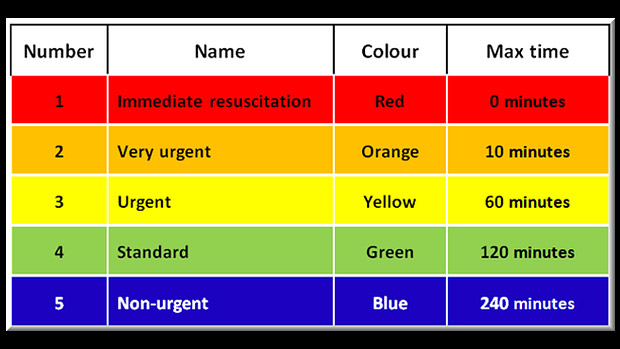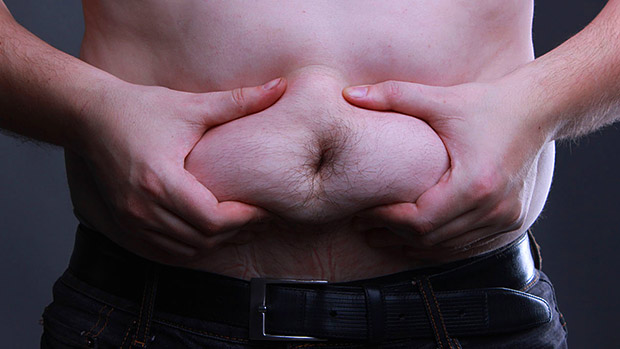Emergency!
If you find yourself sitting in an emergency room this weekend, take a look around. What do you see? Well, besides drunk people who've made some very bad choices, you'll see some folks getting immediate attention while others wait for hours. It doesn't matter who got there first.
The good news is, if it's YOU who's sitting there waiting for hours then it means you're not that hurt. Your broken finger, twisted ankle, or improperly inserted marital aid can wait.
See, emergency rooms use the triage method. "Triage" is the assignment of degrees of urgency to wounds. Whoever is hurt the most goes first. Some even have a chart they go by:

You should approach your fat loss efforts the same way.
When you decide it's time to not be chubby anymore, or you'd like to finally turn that blurry 4-pack into a sharper 6-pack, you have a lot of choices to make, most of them involving nutrition.
Your first impulse might be to find a "diet" – some strict, pre-written plan with a lot of rules. But chances are, you have a few obvious issues that could be taken care of first.
Here's a real-life example. Diane told me she wanted to try a keto diet. She asked me what I thought about that. Instead of telling her, I asked a few questions:
- Do you currently drink sodas?
- Do you eat fast food and junk food? How often?
- Do you go to the gym? What do you do there?
Diane didn't know it, but I was putting her through triage. I was trying to find out how badly she was "bleeding." Turns out, Diane drank sodas, ate fast food once per day, and only went to the gym to walk on the treadmill.
In short, keto could wait. In fact, it probably wouldn't ever be necessary for her goals. Her chances of being successful on such a restrictive, life-altering plan like keto were slim to none anyway.
Using the triage method, we identified her "emergency" problems, and all of them could be fixed with simple changes.
People are drawn to the "new" and shiny. They're drawn to the extremes. They want to run a marathon when they haven't tried jogging a mile first. They think they can never eat a carb again when currently they can't even go three hours without a liquid sugar injection.
With the triage method, you identify your biggest problem, that thing that's holding you back, and take care of it first. Then you move to the second-biggest problem, just like an emergency room doctor choosing which patients need help first.
I advised Diane to drop the sodas. If she can do that, then she'll drop several pounds of fat and keep it off. Then we'd talk about the next step – which won't be keto. That step will probably be weaning her off the drive-through food and teaching her about Sunday meal prep. Then we'll talk about weight training. And so on.
You're probably not like Diane, but if you have some fat to lose then you're clearly bleeding from somewhere. But where? Think about it. Don't jump to an extreme plan just yet. Triage yourself. Some ideas:
- Are those cheat meals coming around a little too often?
- Are you eating late at night?
- Are you drinking alcohol in excess too often?
- Are you eating your kids' leftovers?
- Does your coffee stop in the morning involve a 300-calorie drink order?
- Are you skipping breakfast and overcompensating later in the day? Or, does your breakfast come out of a box with a cartoon character on it?
- Are you getting about a gram of protein per pound of bodyweight?
- Does that "clean" lunch at Chipotle actually add up to 1500 calories? Has it been a while since you've tracked calories and macros?
- Are you knocking out half a jar of almond butter in one sitting? (I'm talking to myself on this one.)
- Training wise, are you avoiding cardio or any type metabolic conditioning?
- Are you resting 17 minutes between sets, never really getting out of breath, and never doing more than two reps at a time because "it's all about strength, bro?"
- Can you pass the 1-Mile Fitness For Lifters?
Pretend that all your dietary habits, workout choices, meals, and daily activities are people, and all of them are sitting in the emergency room.
Now, who needs to be rushed back to the see the doctor STAT? Be honest. List everything out, from needs-fixed-fast to not-perfect-but-not-a-big-deal.
First, take care of the "person" at the top of the list. (For Diane, that was her soda habit. BIG problem, needs attention fast.) Spend a week or two there. When that's taken care of, triage your way on down the list.
Chances are, the fat will begin to drop off and you'll never have to go crazy on a strict diet or twice-a-day training plan. And these changes will be sustainable – healed forever.




